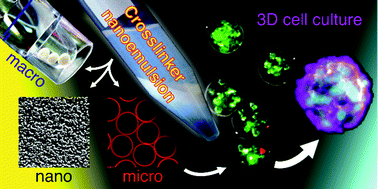Nanoemulsion-induced enzymatic crosslinking of tyramine-functionalized polymer droplets†
Abstract
In situ gelation of water-in-oil polymer emulsions is a key method to produce hydrogel particles. Although this approach is in principle ideal for encapsulating bioactive components such as cells, the oil phase can interfere with straightforward presentation of crosslinker molecules. Several approaches have been developed to induce in-emulsion gelation by exploiting the triggered generation or release of crosslinker molecules. However, these methods typically rely on photo- or acid-based reactions that are detrimental to cell survival and functioning. In this work, we demonstrate the diffusion-based supplementation of small molecules for the in-emulsion gelation of multiple tyramine-functionalized polymers via enzymatic crosslinking using a H2O2/oil nanoemulsion. This strategy is compatible with various emulsification techniques, thereby readily supporting the formation of monodisperse hydrogel particles spanning multiple length scales ranging from the nano- to the millimeter. As proof of principle, we leveraged droplet microfluidics in combination with the cytocompatible nature of enzymatic crosslinking to engineer hollow cell-laden hydrogel microcapsules that support the formation of viable and functional 3D microtissues. The straightforward, universal, and cytocompatible nature of nanoemulsion-induced enzymatic crosslinking facilitates its rapid and widespread use in numerous food, pharma, and life science applications.



 Please wait while we load your content...
Please wait while we load your content...